 |
The Unit
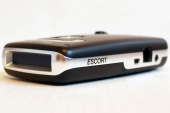 |
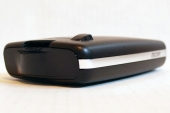 |
The first thing you notice when you pull the Passport Max out is the size and weight. This thing is hefty and about the size of a smartphone (but about three times as thick).
One the front we see the OLED display, which is relatively small compared to the rest of the unit. On the right side is the power jack (a standard phone plug), a headphone jack, and a Mini USB jack (for updating on your PC).
Around back we see the business end where cop beams come in, some magic happens, and beeps come out, with an end result of no speeding tickets. Above the main “eye” you can see the small bump for the laser detector.
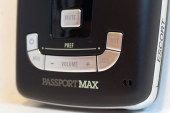 |
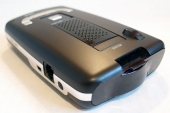 |
All controls are located on the top of the unit which might prove tricky if you mount it right under your rearview mirror.
Each buttons is large and easy to press, allowing for quick and precise changes so you keep your eyes on the road.
The MRK button is to mark a location, the BRT button adjusts the brightness (min, med, max, auto, or off), and SEN adjusts sensitivity (auto, auto no x, or highway).
The small opening you see above the “eye” is where your mounting clip snaps in. You then press the button above that to release.
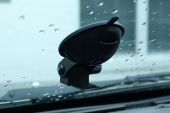 |
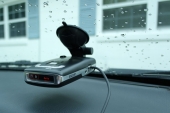 |
The “sticky cup” portion of the mount is extremely strong and more than capable of holding the detector up, but the insanely small clip that actually slides in to the unit is a joke. When you have a device that weighs as much as this does bouncing up an down in a car, a thin sliver of plastic mounted to only one end just doesn’t cut it.
Going down anything but the smoothest of roads causes the detector to shake and bounce quite noticeably. Every time I hit a pothole I was afraid the mount would break and my expensive detector would smash to the floor.
On Screen
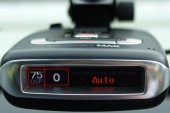 |
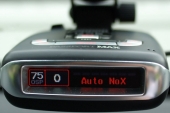 |
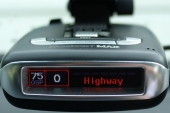 |
The OLED display is crisp, bright, and actually fairly pleasant to look at compared to most other detectors.
When you are driving down the road the display will look like one of these three pictures depending on which sensitivity mode you are in.
The number on the far left is your overspeed limit which, when exceeded, will cause the detector to give a small alert. It can be adjusted/disabled easily. Next to that is your current speed as calculated by GPS.
In the auto modes the sensitivity of the unit is adjusted according to your speed. This is a great feature because if you are going 35 mph around town you don’t need to be alerted of the automatic door 2 blocks away. As speed increases, so does sensitivity. The NoX just means that X band is filtered out which helps to greatly reduce false alarms (since almost no cops use X band radar anymore). Highway mode gives max sensitivity, allowing you to detect those bogeys long before they can get to you.
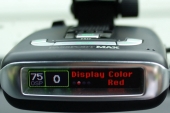 |
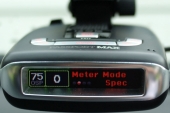 |
Display color can be changed between red, green, blue, and amber so you can match it to your gauge lights for extra style points.
Meter mode allows you to adjust how advanced you want your display. I preferred “spec” mode as it gave a good balance between too simple to be of use and overly complicated. You get a bar graph showing signal strength, the band next to that, and the frequency above.
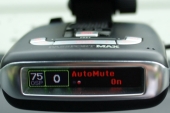 |
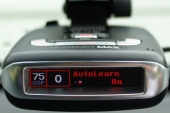 |
The AutoMute feature will alert you of a signal at full volume for the first few seconds and then turn down the volume some so that you can still hear it but it isn’t as obnoxious.
The AutoLearn feature automatically store and locks out false alarms. This feature helps to dramatically reduce false alerts on routes you take often.
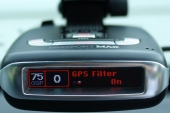 |
 |
The GPS Filter setting just enables or disables GPS.
Band Enables allows you to choose which bands you want to detect. Most people will want to leave this alone.

The primary function of a Radar Detector is to alert you to potential threats, and that is where the new Passport Max disappoints. Here is a link to a video where the author demonstrates how Escort Autolearn can inadvertently lock out a legitimate K band speed trap: http://www.youtube.com/watch?v=mIoVVSmuAdA&feature=c4-overview&list=UUgLr7xoTU3XgAeLrEYp51sw. The detector in the video is an Escort Redline, but it has the same flawed feature as the Max. You can read for yourself the other problems with this detector on an unbiased forum: http://www.radardetectorforum.org, or even browse the Escort Radar Forum.
For the price, this detector should be perfect. Yet there are numerous complaints of the Max “locking up” and having to be reset, Ka band false alerts in the middle of nowhere, oscillating mount, hard to read OLED display, inconsistent sensitivity to radar amongst similar units, etc. It really seems to be hit or miss if you get a “good” one, with forum members having to send theirs in for service 2 or 3 times to get the problems fixed. Most recently, a software glitch caused all the radar bands to be turned off after an update with the result that you had a “sleeping beauty” not detecting anything. It was only after several forum members received speeding tickets that Escort sent out an email to registered owners warning them of this problem. Bottom line here is not to be taken in by the marketing hype. Do your homework before you spend this much money as the Passport Max is most definitely not the best radar detector money can buy. If you do not need the most sensitive detector out there and do mostly city driving, buy a Whistler CR90. If you want the best, the Escort Redline and the Valentine V1 are the 2 top rated windshield detectors in the world. Given Escort’s problems with quality assurance of late, I would recommend the Valentine V1.
When combined with the Valentine V1C Bluetooth dongle and a new free app on Google Play called “YAV1”, GPS capability to lock out false alerts is added to the Valentine V1. It is so effective at locking out false alerts yet not blocking genuine Police Radar at the same time that most experts are starting to call the V1 + YAV1 the detector of choice in Metro areas. You can read more about YAV1 on http://www.radardetectorforum.org in the Valentine section, or on Google Play. It will not lock out a genuine K band speed trap, and it will not disappoint you.
I wrote my review based on my experiences with the product and I have to say that I never had any of the issues you mentioned (aside from the mount which I went over extensively).
During testing and in the months I have been using it after the review I have not once had a legitimate signal locked out.
I unfortunately don’t have another Max and a radar gun to test the inconsistencies you mention. Obviously if the differences are large then it is a serious problem, but I have had no issues with my unit yet.
I received an email from Escort about the software glitch you mentioned and that is clearly a huge flaw, though it was only an issue in very specific circumstances. Fortunately for me I had been pretty lazy about updates and wasn’t affected.
From other Max owners that I have spoken to since the time of this review, there seem to be some quality control issues where the outer shell starts to separate. I don’t have this problem on mine but those who did sent it off to Escort and had a replacement back in just a few days.
I have a feeling that it’s not that I have a “good” unit per say, just that the people with the “bad” units are the outspoken minority.
For anyone looking to buy this detector I would urge you to do your research and come to your own conclusion, but I still stand by my recommendation as I believe this is still an amazing detector.
All this has been fixed. that is what’s so great about the max you can upgrade it. all is good with v1.6!